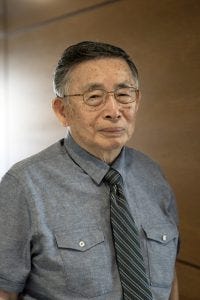For the last four decades and more, I knew him as Yamaoka sensei. During that time he taught me many things. Not in the sense of formal education, but from having had the honor to work alongside him in pursuit of shared goals. Probably the most important lesson I learned from him was that ministry is not about building an institution, nor about building a reputation. Ministry is about service to others, no matter who they are, no matter what identity they embrace, no matter what their ethnicity, race, religion. For him, the Pure Land was open to all.
Yamaoka sensei completed two degrees at the Pacific School of Religion at The Graduate Theological Union, a Master’s in Religious Education (M.R.E.) and a Doctor of Ministry (D.Min.), and two degrees from Ryukoku University in Kyoto, an M.A., and a D.Litt. (Ryukoku University at that time employed the European system in which the D.Litt. corresponds to the American Ph.D.). He promoted the IBS, so both professionally and personally, I benefitted from his support.
He died last week, and I am saddened. Many will say that he has surely been born in Amida’s Pure Land. Who am I to say otherwise?
He wrote Shin Buddhist Education: A New Perspective <link>, which presented the ideas he had developed over decades of ministry.
In memory of his life, and service, here is the Series Editor’s Foreword from that volume (pp. ix–x).
It could be said that the buddhadharma has always been in a process of transmission. From the time Śākyamuni first spoke with his fellow renunciants after his awakening right through to the present day, the teachings have moved forward and spread through direct transmission from person to person. The true basis of all of our study and understanding of the history of Buddhism comes from this person-to-person transmission.
The early transmitters of the dharma made the journey from India following the caravan routes of the Silk Road or the maritime routes of merchant trade to China, and then on to Korea and Japan; others brought the teachings with them as they traveled south to Sri Lanka and through the kingdoms of Southeast Asia as far as Java, and still others moved across the Tibetan plateau and into Mongolia—people teaching people.
In the modern era, people from across the entire range of Buddhist traditions brought their understanding of the teachings to Europe and America. The Buddhist Churches of America began, well over a century ago, because Japanese Buddhist immigrants in the United States asked for ministers to be sent to this country to provide guidance and teaching. Two ministers—two people—answered that call, left their homeland, and came to San Francisco.
I know personally that Seigen Yamaoka sensei has honed the guidance he has recorded in this volume for decades. What comes through—at least for me—as most important is how building personal relationships between minister and sangha member, or chaplain and client, is a matter of the former’s openness to the reality of the latter’s life situation, life experience, and what Yamaoka sensei calls here their “life process.”
When he served as Bishop of the Buddhist Churches of America, a fifteen-year tenure, Yamaoka sensei’s major concern was to create a meaningful balance between two aspects critical to the successful transmission of the Shin teachings. The first aspect is the way that the teachings had been formulated in Japan over the centuries since Shinran Shōnin’s time up to the present: respect for tradition and the proper understanding and interpretation has been essential to maintaining the integrity of the Shin lineage. This is far from the kind of “anything goes,” “whatever feels good” attitude that some of us who came of age in the period of the Beats and hippies brought to our engagement with Buddhism. We now know that such attitudes can dilute the teachings and all too often defuse their transformative potential, allowing Western Buddhism to become just another product in a consumerist society—sometimes in fashion and sometimes not.
The second aspect is the immediate lived experience of each individual. The sangha for whom Yamaoka sensei served as minister for so long, and continues to serve through this book, is located in modern America. The cultural milieu within which these sangha members live is markedly different from their counterparts in modern Japan, just as modern Japan differs greatly from the medieval Japan in which Shinran studied, practiced, and taught. In both of these cases, however, change, adaptation, and interpretation are required in order to transmit the teachings effectively, and it also requires connecting with people on a personal level. One of the things I find so moving about the letters of Shinran Shōnin is how they demonstrate the close personal relationships the founder shared with individual members of his community.
I have seen how the personal character of what Yamaoka sensei has formulated in this work has reached not only aspirants for the BCA ministry but also practitioners and students of insight meditation, Tibetan Buddhism, and Zen. Perhaps most inspiring is that chaplaincy students, whether Buddhist or not, have found Yamaoka sensei’s approach to Buddhist education meaningful as they move forward into a life of service.
The Institute of Buddhist Studies (IBS) is very happy to publish this revised version of Rev. Dr. Yamaoka’s classic work of Dharma transmission, Shin Buddhist Education: A New Perspective. Yamaoka sensei has demonstrated a lifelong commitment to the propagation of Shin teachings in the United States, and one manifestation of this commitment has been his unswerving support of IBS. We honor his accomplishments and seek to make his approach to adapting the Shin teachings to a Western cultural milieu more widely available through this publication.
We also thank BDK America for its continuing support of IBS and its projects, including the Contemporary Issues in Buddhist Studies publication series.



